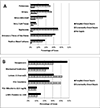Epidemiology of Hospital-Onset Versus Community-Onset Sepsis in U.S. Hospitals and Association With Mortality: A Retrospective Analysis Using Electronic Clinical Data
- PMID: 31135503
- PMCID: PMC6697188
- DOI: 10.1097/CCM.0000000000003817
Epidemiology of Hospital-Onset Versus Community-Onset Sepsis in U.S. Hospitals and Association With Mortality: A Retrospective Analysis Using Electronic Clinical Data
Abstract
Objectives: Prior studies have reported that hospital-onset sepsis is associated with higher mortality rates than community-onset sepsis. Most studies, however, have used inconsistent case-finding methods and applied limited risk-adjustment for potential confounders. We used consistent sepsis criteria and detailed electronic clinical data to elucidate the epidemiology and mortality associated with hospital-onset sepsis.
Design: Retrospective cohort study.
Setting: 136 U.S. hospitals in the Cerner HealthFacts dataset.
Patients: Adults hospitalized in 2009-2015.
Interventions: None.
Measurements and main results: We identified sepsis using Centers for Disease Control and Prevention Adult Sepsis Event criteria and estimated the risk of in-hospital death for hospital-onset sepsis versus community-onset sepsis using logistic regression models. In patients admitted without community-onset sepsis, we estimated risk of death associated with hospital-onset sepsis using Cox regression models with sepsis as a time-varying covariate. Models were adjusted for baseline characteristics and severity of illness. Among 2.2 million hospitalizations, there were 95,154 sepsis cases: 83,620 (87.9%) community-onset sepsis and 11,534 (12.1%) hospital-onset sepsis (0.5% of hospitalized cohort). Compared to community-onset sepsis, hospital-onset sepsis patients were younger (median 66 vs 68 yr) but had more comorbidities (median Elixhauser score 14 vs 11), higher Sequential Organ Failure Assessment scores (median 4 vs 3), higher ICU admission rates (61% vs 44%), longer hospital length of stay (median 19 vs 8 d), and higher in-hospital mortality (33% vs 17%) (p < 0.001 for all comparisons). On multivariate analysis, hospital-onset sepsis was associated with higher mortality versus community-onset sepsis (odds ratio, 2.1; 95% CI, 2.0-2.2) and patients admitted without sepsis (hazard ratio, 3.0; 95% CI, 2.9-3.2).
Conclusions: Hospital-onset sepsis complicated one in 200 hospitalizations and accounted for one in eight sepsis cases, with one in three patients dying in-hospital. Hospital-onset sepsis preferentially afflicted ill patients but even after risk-adjustment, they were twice as likely to die as community-onset sepsis patients; in patients admitted without sepsis, hospital-onset sepsis tripled the risk of death. Hospital-onset sepsis is an important target for surveillance, prevention, and quality improvement initiatives.
Figures


References
-
- Rivers E, Nguyen B, Havstad S et al.: Early goal-directed therapy in the treatment of severe sepsis and septic shock. N Engl J Med 2001, 345(19):1368–1377. - PubMed
-
- Investigators A, Group ACT, Peake SL et al.: Goal-directed resuscitation for patients with early septic shock. N Engl J Med 2014, 371(16):1496–1506. - PubMed
Publication types
MeSH terms
Grants and funding
LinkOut - more resources
Full Text Sources
Medical

